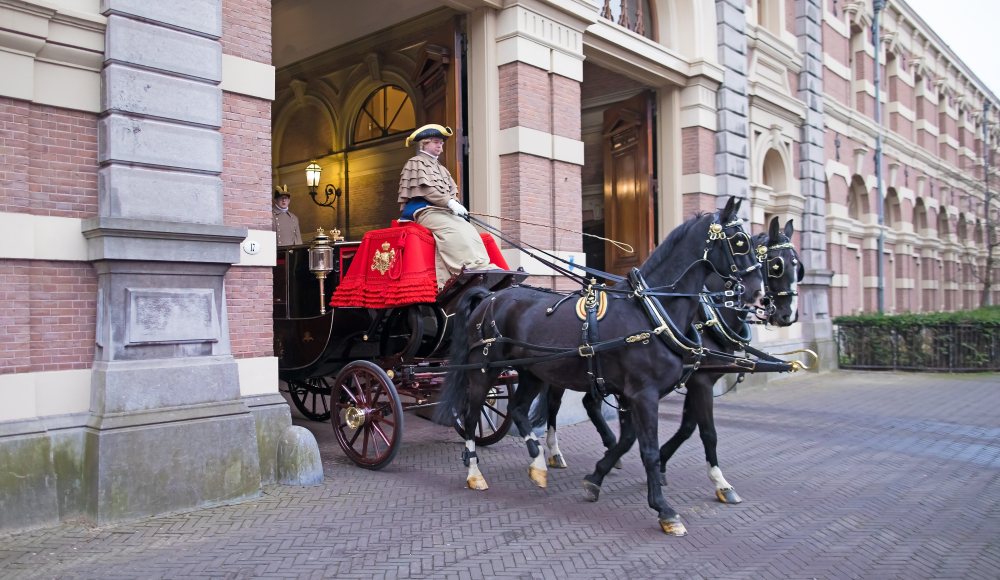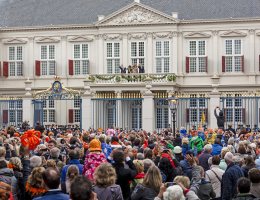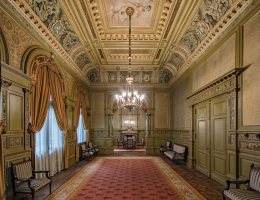Prince Maurits was the first to settle in the city. In 1585 he took up residence in the Stadtholder's Quarter where the Parliament Buildings are and built the Maurits tower, named after him, making The Hague a royal city. A real court culture only emerged under Maurit's successor and half-brother Prince Frederik Hendrik. He greatly expanded the court and gave great parties. Stadtholder Frederik Hendrik also had several palaces built, such as Honselaarsdijk Palace in Westland and Huis ter Nieuburch in Rijswijk (both demolished later) and Huis ten Bosch.
Even after the time of the republic and the stadtholdership, The Hague remained in the 19th and 20th centuries the royal city where the Oranges lived and worked as kings and queens. Only Queen Juliana preferred Soestdijk Palace in Baarn and showed little in The Hague. At that time, The Hague was the city of empty palaces. Her successor Queen Beatrix did settle in The Hague; she moved into Huis ten Bosch in 1981. Noordeinde Palace became her working palace.
Her son Prince Willem-Alexander settled with his family on the Wassenaar estate Eikenhorst. Under Queen Juliana, The Hague is the city of empty palaces. Juliana lives at the Soestdijk palace in Baarn and rarely shows herself in The Hague. Her successor Beatrix does settle in The Hague; she moved into Huis ten Bosch in 1981. Noordeinde Palace will be her working palace. Her son Prince Willem-Alexander settled with his family on the Wassenaar Eikenhorst estate. He will continue to live there after his accession to the throne, until Huis ten Bosch has undergone a complete restoration.
Court life has long ceased to be as exuberant as it was in the 17th and 18th centuries. Only on a few occasions, such as Prinsjesdag (opening of the parliamentary year), can you still notice the regal display of yesteryear. They are also public moments where the residents of The Hague share in the joy or sorrow of this family.

Parties and driving tours
The Hague is pre-eminently the place where one can see the Oranges “in real life”, for example during Prinsjesdag (opening of the parliamentary year). Until well into the 20th century, the Oranges allowed themselves to be driven around the city on other occasions. The residents of The Hague went out of their way to offer the stadholders and kings a suitable stage. Bows of honour, party decorations and of course many flags adorned the streetscape at these events. For a long time, the Oranges showed themselves at the most popular festival in The Hague, the Funfair in May. In the 17th and 18th centuries, the visit of the stadtholder and his family was the annual highlight of this fair.
Royal top- Oranje maligned
Varying popularity
However there was more than just partying. The position of the stadholders and kings of the House of Orange-Nassau was and still is a subject of discussion. Over the centuries, the Oranges were more or less popular. During the so-called stadtholderless periods in the 17th and 18th centuries, the House of Orange were sidelined by political opponents. At the end of the 18th century, for example, more and more citizens resisted the power of the House of Orange. Opposite to this group, better known as the so-called the patriots, were the Orange-minded, who supported Stadtholder William V. Their infighting was not only fought on the street, but also in pamphlets, on badges and with images on glassware and dinnerware.
The royal family also experienced several critical moments in the 19th and 20th centuries. In 1918 the socialist politician Troelstra made an attempt to start a revolution and remove Queen Wilhelmina from the throne. The battle between the supporters and opponents of the House of Orange was often fought in the audience, with a lot of street noise and manifestations.
The royal family is still a regular topic of discussion. Various political parties want a purely ceremonial kingship. Nevertheless, the Royal family is still very popular among the Dutch population. The Netherlands has countless Orange associations and Orange souvenirs are in great demand.
Court and Village
The origins of The Hague go back several centuries before the arrival of the House of Orange. Even before their arrival it was a village serving the court. It actually originated from two medieval centres: on the one hand the count's court at the Royal lake, on the other the village of Die Haghe (The Hague) around the Great Church. Although closely related, they remained separate worlds for a long time. Both had their own administration: in the area of the Parliament buildings, the government of Holland was in charge; in the village the local government had the power. Both also had their own coat of arms: the red lion of the province of Holland and, from the 16th century, the stork of the village of Die Haghe.
In addition to their own administration, the court and village also had their own court and their own militia guild. The separation was clearly visible in the street scene. Senior civil servants owned beautiful houses located on spacious streets around the Parliament buildings and the Royal lake. The artisans and merchants lived in small houses in narrow streets and alleys around the Groenmarkt. Many of these craftsmen began to produce higher quality products over time and deliver them to the court and other notables.
Purveyors to the Court
King William I was the first to award the title of purveyor to the court in 1814. Purveyors to the Court were originally companies that supplied the Court. Later that requirement lapsed. Meritorious companies that had no connection with the Court could now also become purveyors. They did have to exist for at least 100 years. It will come as no surprise that The Hague had and still has a relatively large number of purveyors to the Court. View the purveyors.
King William I
King William I was the first Orange king of the Netherlands. In 1806 Louis Napoleon was the first King of Holland, he was especially important for the development of industry and the improvement of infrastructure through the construction of new roads and canals. After the defeat of Emperor Napoleon, Prince Willem was requested to return to the Netherlands from England. He landed in Scheveningen and presented himself as sovereign Prince William I. On the same Scheveningen beach he had been forced to leave for England with his father, Stadtholder William V, which occurred almost twenty years ago. With his return, the Orange monarchy started in the Netherlands.
Suggestions to immerse yourself in Royal The Hague



